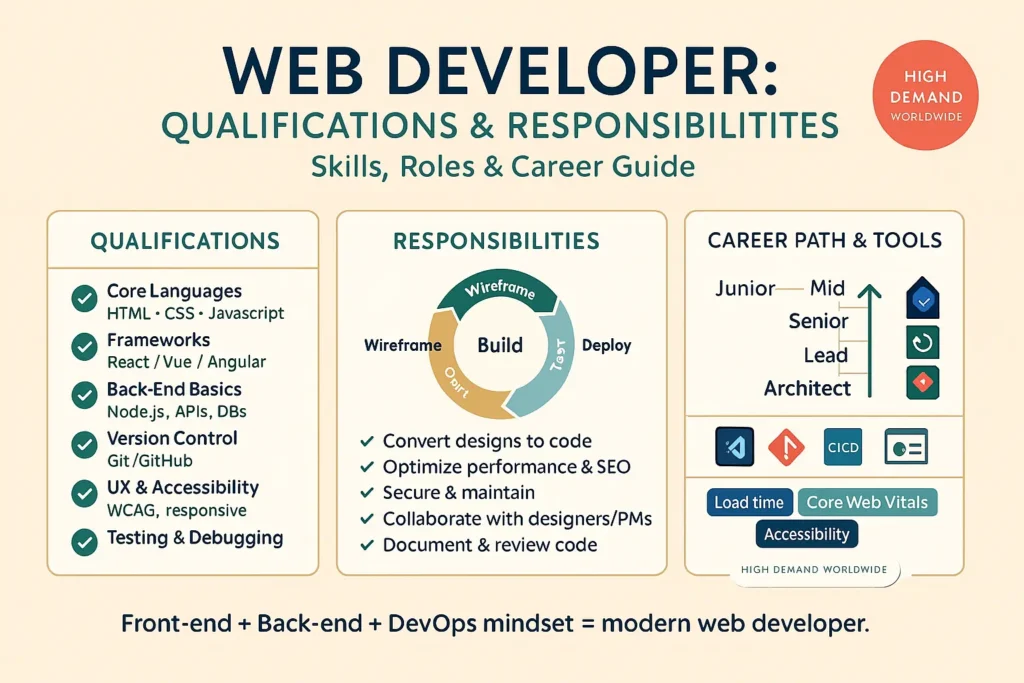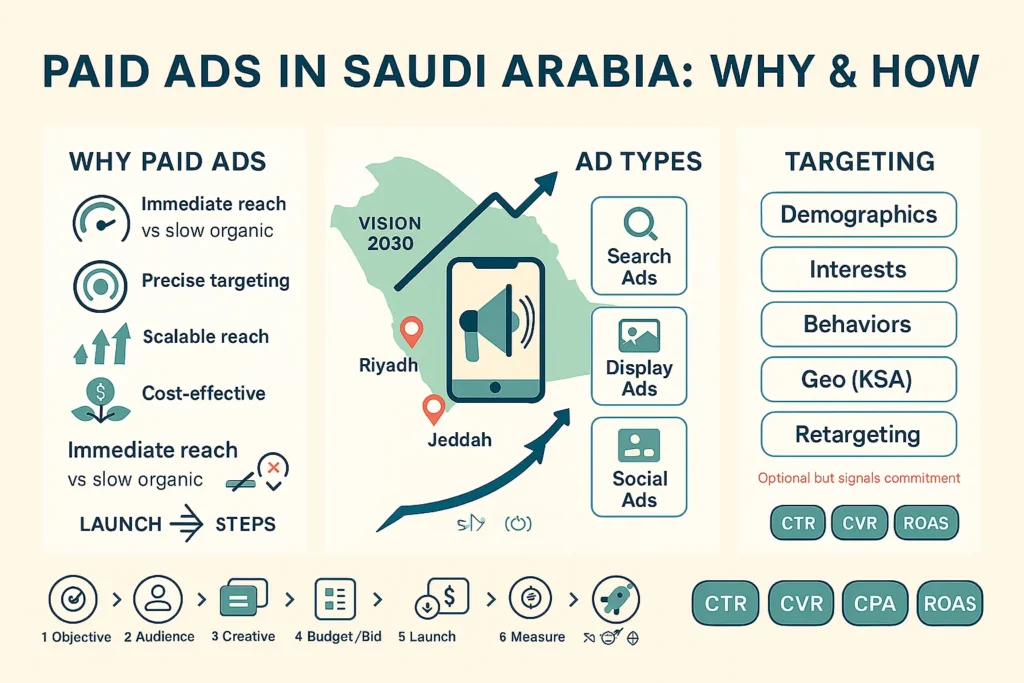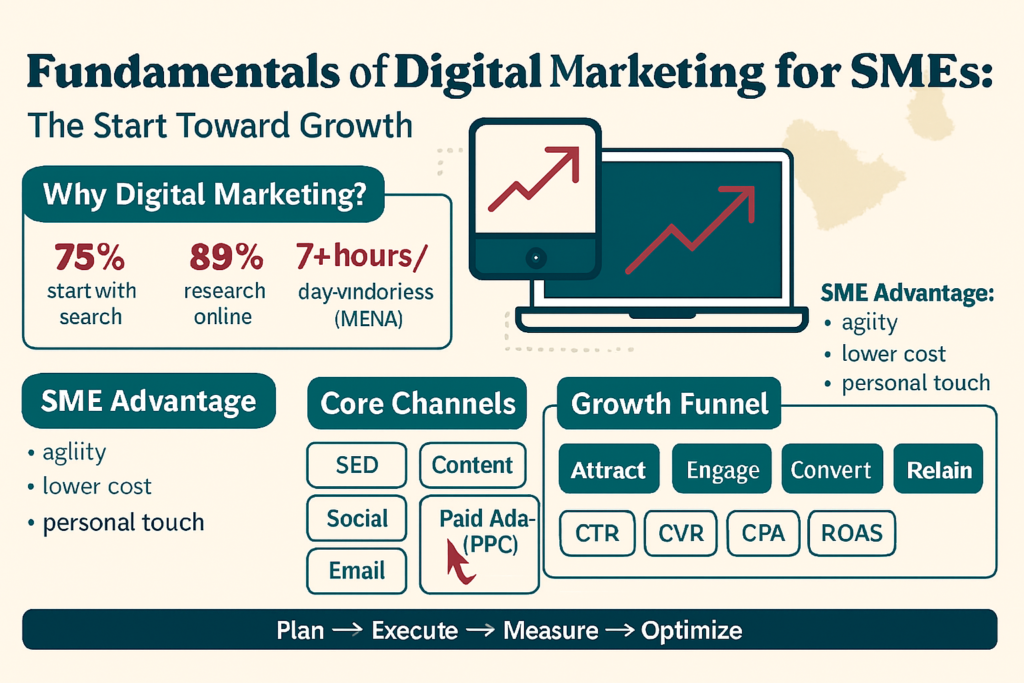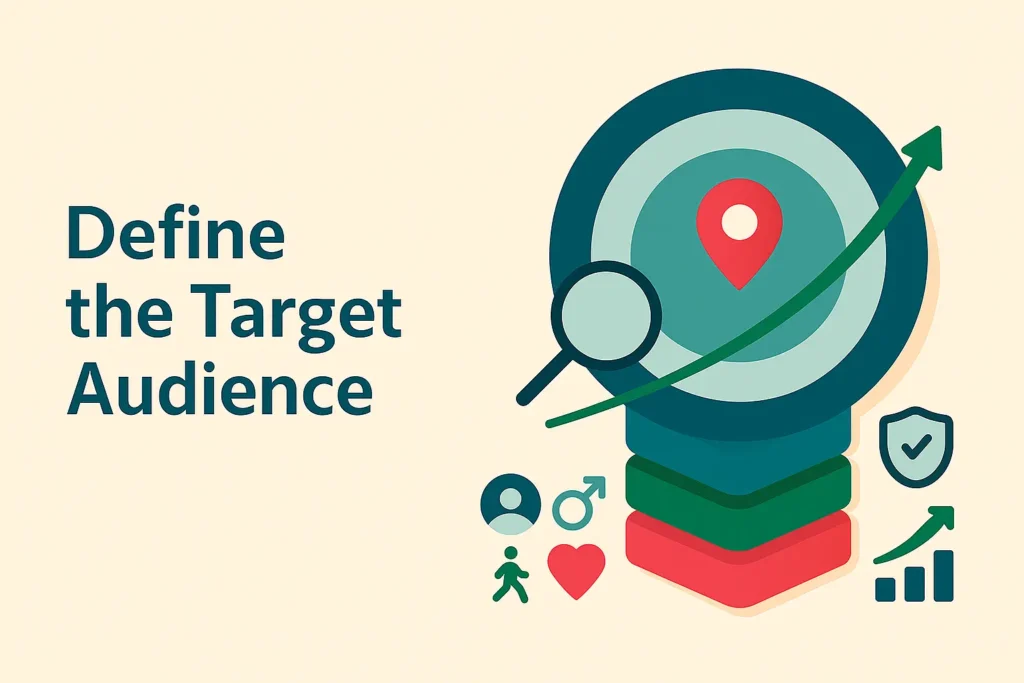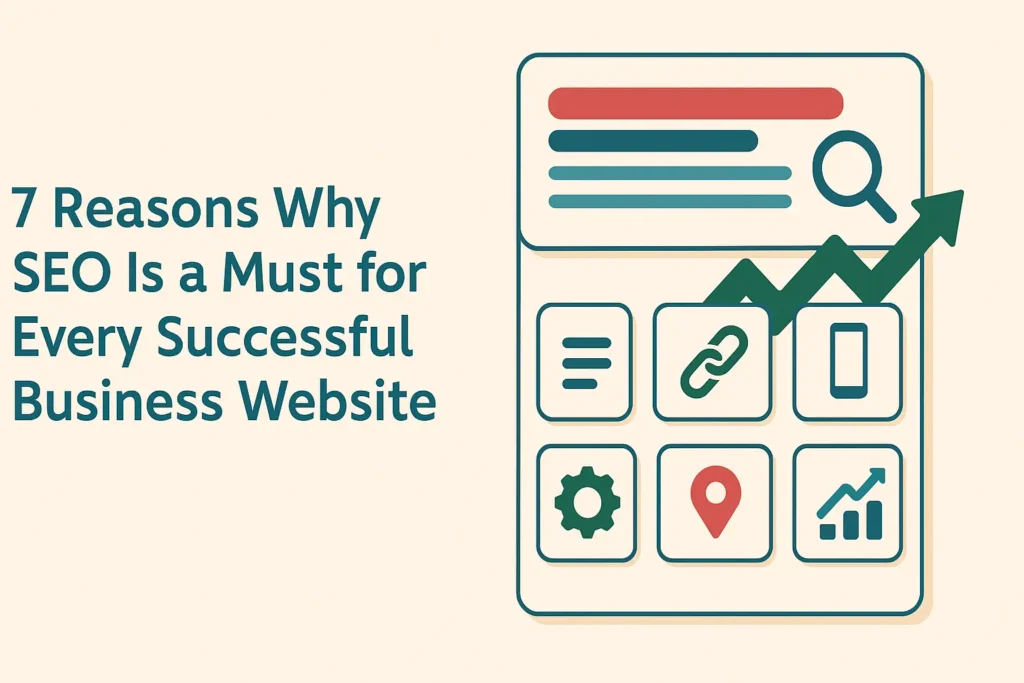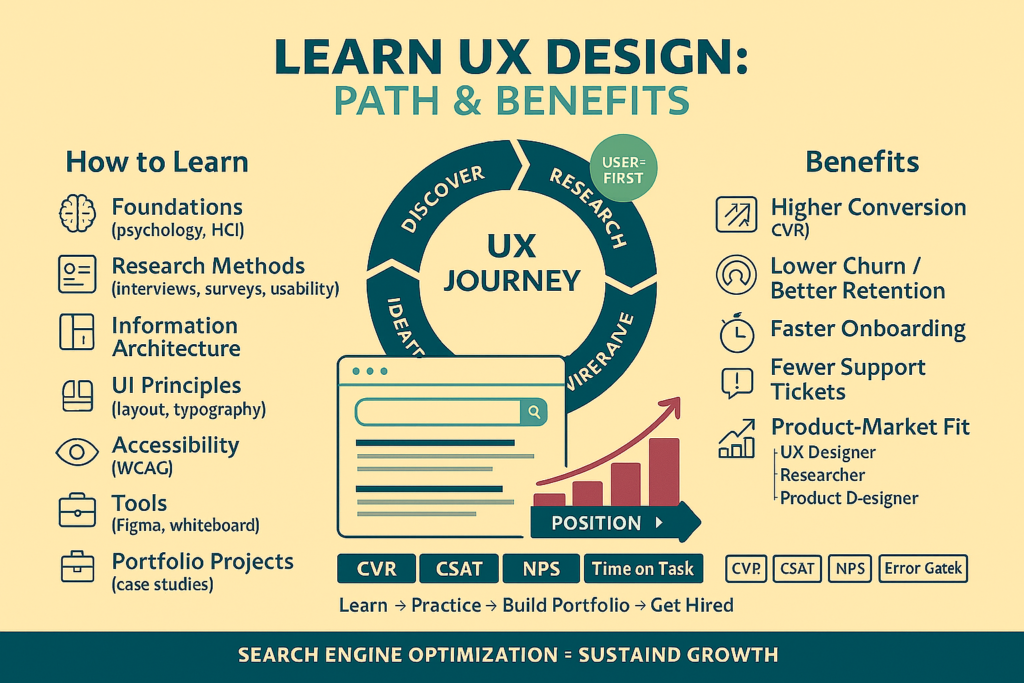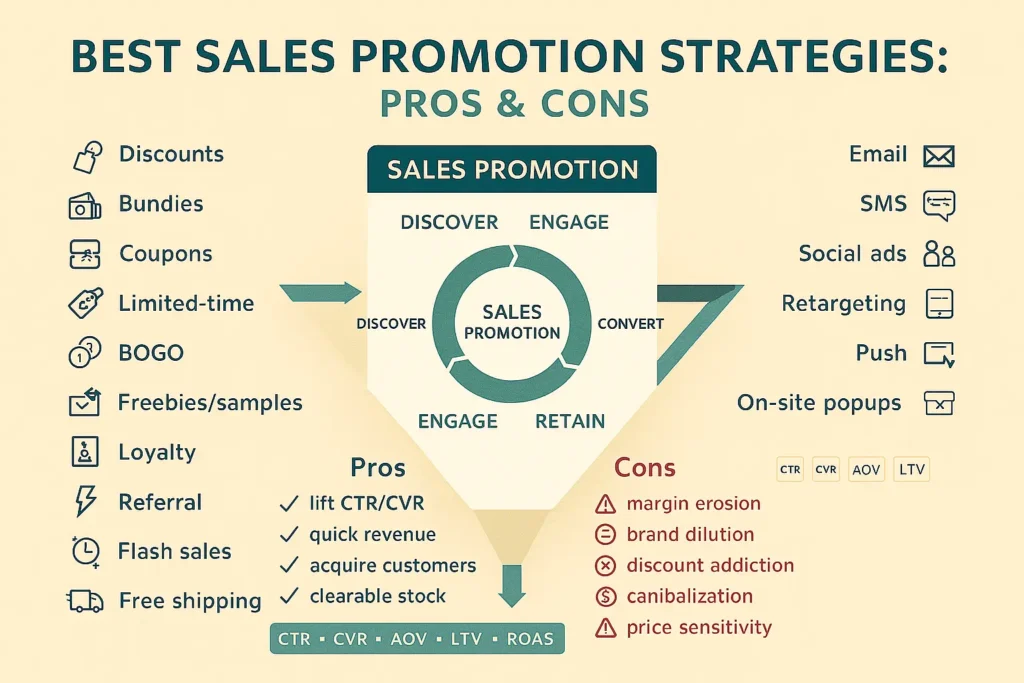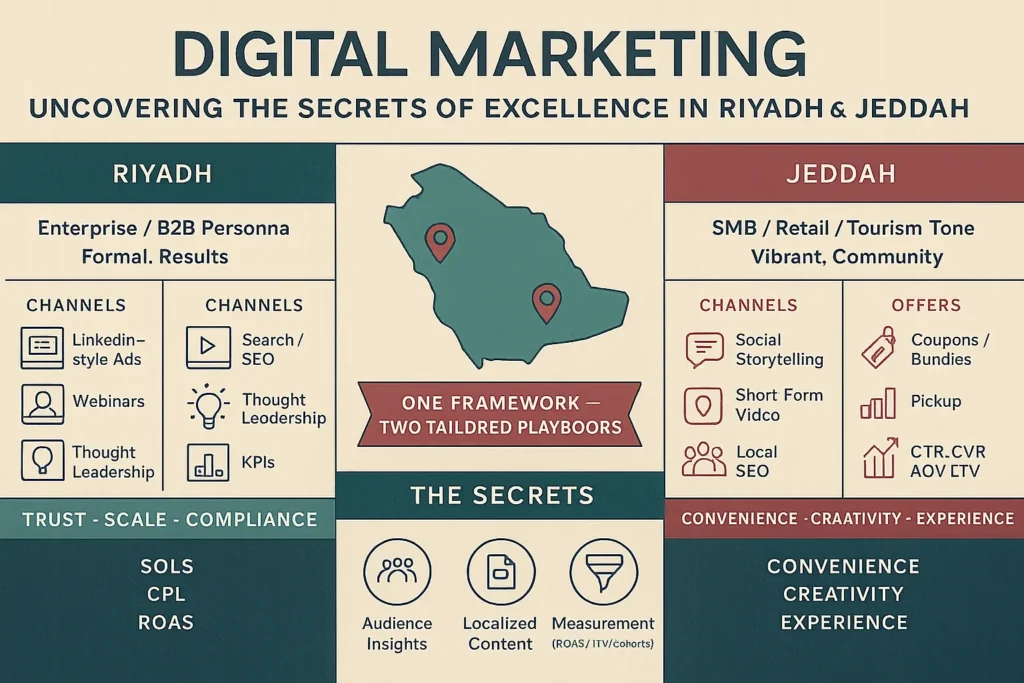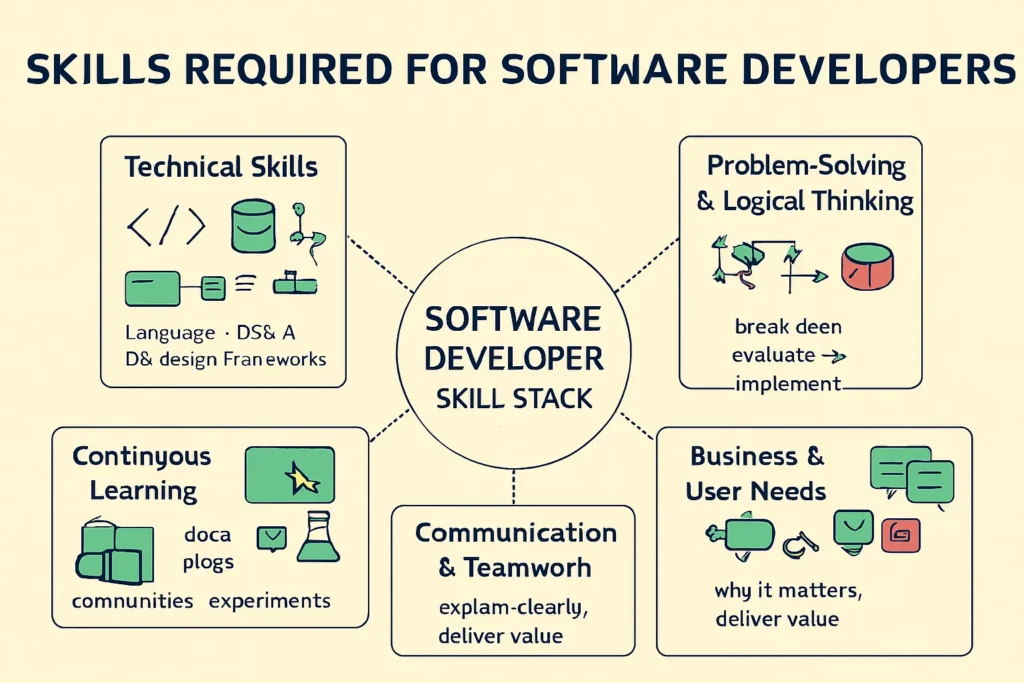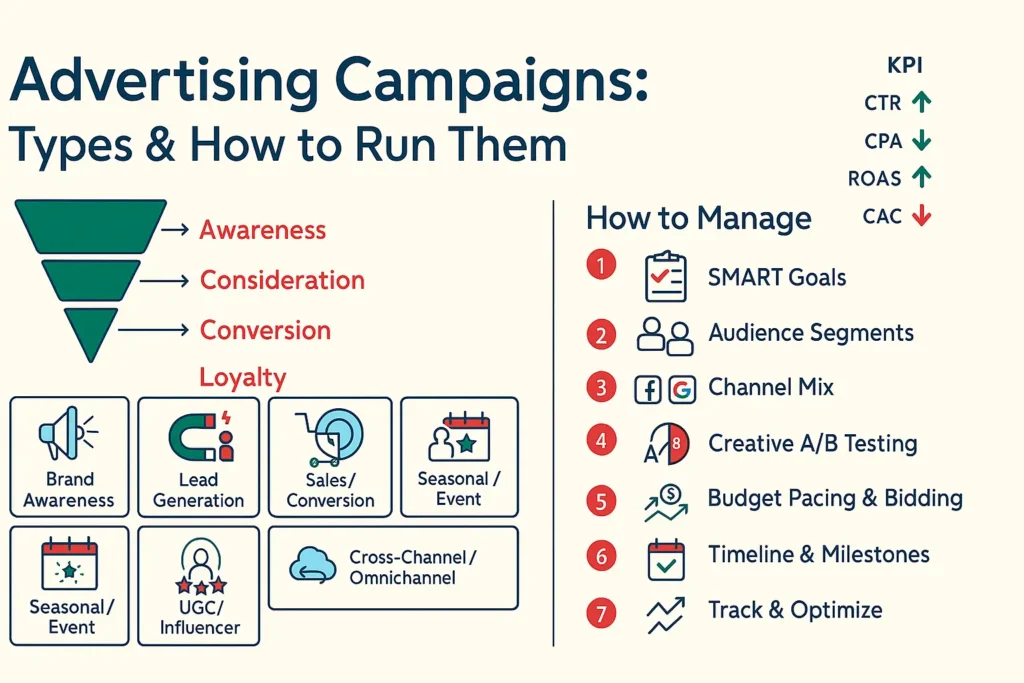
What are the types of advertising campaigns and how do you manage them?
Advertising Campaigns: Types & How to Run Them
In today’s digital era, advertising campaigns have become the cornerstone of business growth. You no longer compete only locally—you face global competition that demands strategic thinking and fresh innovation. The difference between a single ad and a comprehensive advertising campaign lies in sustained impact and the brand awareness that campaigns build over time.
When you invest in advertising campaigns, you’re not just promoting a product or service; you’re building a relationship with your audience that goes far beyond a single interaction. Every successful brand you admire today has leveraged the power of well-planned campaigns to reach its current standing.
The modern business landscape requires you to recognize that advertising campaigns serve multiple purposes at once. They increase brand awareness, generate leads, drive direct sales, and build customer loyalty. Without a diversified campaign strategy, you risk becoming invisible in an increasingly crowded marketplace where consumer attention spans are shorter than ever.
The Core Classification of Advertising Campaigns
Understanding how to categorize advertising campaigns will help you make informed decisions about what best fits your business goals. The classification framework is not just academic—it’s a practical structure that guides your investment decisions and resource allocation.
By primary objective, the classification reveals the strategic intent behind your campaign.
Brand-awareness campaigns focus on making your target audience familiar with your company’s identity and values. These campaigns prioritize reach and frequency over immediate conversions, laying the groundwork for long-term customer relationships. Lead-generation campaigns, on the other hand, are designed to capture prospect information and move them through your sales funnel. Direct-sales campaigns concentrate on immediate revenue, often leveraging strong calls to action and time-sensitive offers.
By advertising medium, the classification helps you understand where your audience consumes content and how they prefer to receive marketing messages. This becomes critical when deciding how to allocate your budget across different platforms and channels.
By target audience, the classification ensures your messages resonate with the right people at the right time. Demographic campaigns might target specific age groups, while psychographic campaigns focus on lifestyles and values. Geographic campaigns tailor messages by location, while behavioral campaigns respond to how audiences interact with your brand online.
By duration, the classification defines your campaign’s lifespan and intensity. Short-term campaigns create urgency and prompt immediate action, while long-term campaigns build sustainable brand presence and customer loyalty over months or years.
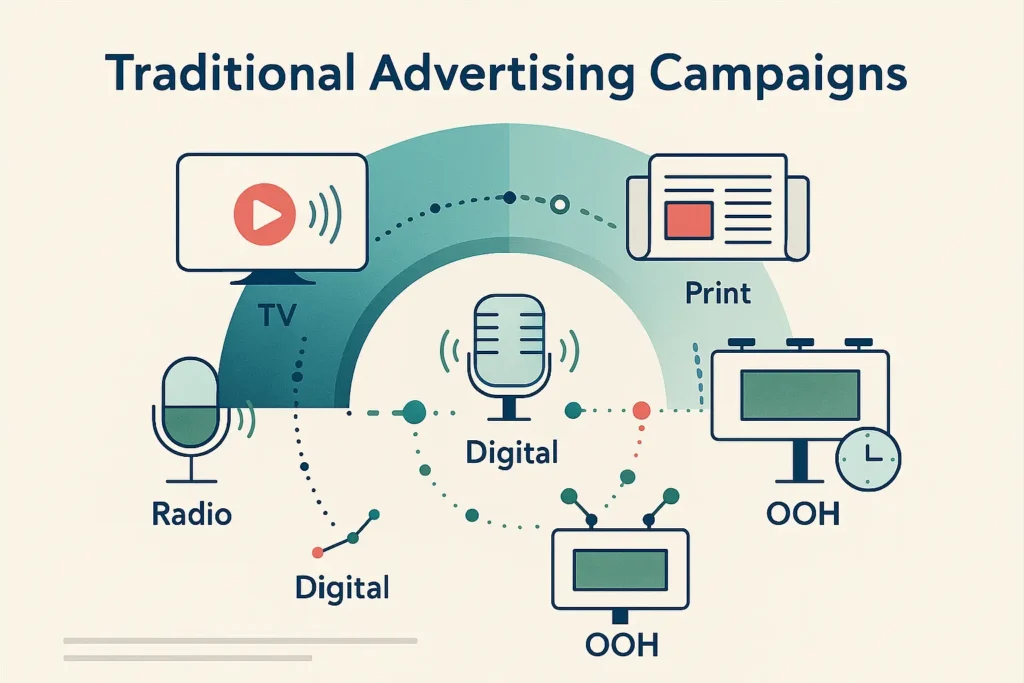
Traditional Advertising Campaigns and Their Enduring Power
Despite the digital revolution, traditional advertising campaigns still carry significant weight in the marketing landscape. Television and radio continue to offer unmatched reach, allowing you to connect with vast audiences simultaneously. The key to success with these media lies in understanding optimal timing strategies—knowing when your target audience is most likely to be engaged with traditional channels.
Television campaigns provide a unique advantage by combining visual and auditory elements to create unforgettable brand experiences. When you develop TV campaigns, you tap into the emotional power of storytelling—still one of the most effective ways to build brand relationships. Radio campaigns, though lacking visuals, offer intimate, personal connections with listeners who often develop loyal relationships with their favorite stations and programs.
Print advertising in newspapers and magazines delivers in-depth information to audiences who value written content and tend to engage with it more deeply. These media allow you to present detailed product information and build credibility through association with trusted publications.
Out-of-home (OOH) and billboard campaigns create unavoidable brand exposure during your audience’s daily routines. These campaigns work exceptionally well for location-dependent businesses and can reinforce messages delivered through other channels.
The most successful modern marketing strategies combine traditional and digital campaigns, creating an all-around brand presence that meets consumers wherever they are in their customer journeys.
Digital Advertising Campaigns and the Modern Marketing Revolution
Digital advertising campaigns have radically transformed how you reach and engage your target audience. Search Engine Marketing (SEM)—especially via Google Ads—captures user attention at the very moment they’re searching for the solutions you provide. Your success with SEM depends on advanced keyword strategies that align search intent with your offerings.
Social media campaigns across platforms like Facebook, Instagram, LinkedIn, and TikTok unlock unprecedented targeting capabilities. Facebook and Instagram excel at visual storytelling and community building, while LinkedIn supports professional networking and B2B relationship development. TikTok leverages short-form video and viral marketing potential, making it especially effective for reaching younger demographics.
Email marketing campaigns remain among the most cost-effective digital strategies. By developing personalized email sequences, you build direct communication channels with your audience that transcend algorithm changes and platform limitations.
Programmatic and smart advertising use AI and machine learning to optimize ad placement, timing, and targeting in real time. These campaigns continuously adapt based on performance data, ensuring your ad budget drives maximum ROI.
The power of digital campaigns lies in their measurability and adaptability. Unlike traditional campaigns, digital efforts provide immediate feedback, enabling you to optimize performance while campaigns are live.
Specialized and Innovative Campaign Types
Content-marketing campaigns position your brand as an industry authority by delivering valuable information that solves customer problems. Over time, these campaigns build trust and credibility—creating durable competitive advantages that competitors find hard to replicate.
Influencer-marketing campaigns tap into the trust and relationships that social-media personalities have built with their audiences. Partnering with influencers lets you reach established communities aligned with your target demographics, often generating higher engagement than traditional ad formats.
Retargeting and remarketing campaigns reconnect with prospects who previously engaged with your brand but didn’t complete desired actions. These cost-efficient efforts target warm audiences already familiar with your offerings.
Interactive campaigns and contests create engaging experiences that encourage active audience participation. They generate user-generated content, boost brand awareness through social sharing, and provide valuable customer insights.
Event-based and occasion-driven campaigns align with specific customer life moments or calendar events, forging emotional connections by associating your brand with memorable experiences and celebrations.
Digital PR campaigns blend traditional public-relations strategy with online distribution channels, allowing tighter message control and broader reach across multiple touchpoints.
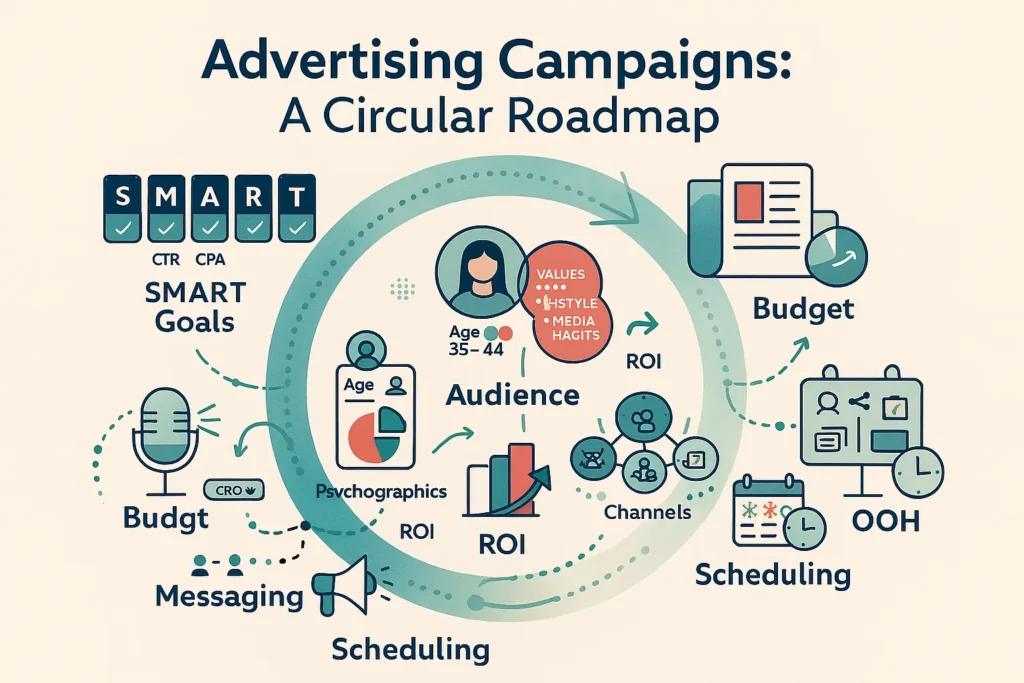
Strategic Planning for Successful Advertising Campaigns
An effective campaign-planning process begins with establishing SMART goals—objectives that are Specific, Measurable, Achievable, Relevant, and Time-bound. Your goals should align with broader business objectives and provide clear metrics for evaluating success.
Audience research and analysis form the foundation of successful campaigns. You need to understand not only demographics but also psychographic data, including values, interests, lifestyle preferences, and media-consumption habits. This deep understanding enables you to craft messages that resonate emotionally with your target audience.
Budget allocation and distribution require careful consideration of the channels and tactics that will yield the best ROI. Your budget should reflect opportunities to test new approaches as well as proven strategies that have delivered results in the past.
Platform and channel selection depends on where your target audience spends their time and how they prefer to consume content. The most effective campaigns often use multiple channels working together to reinforce messaging and increase touchpoints.
Developing core messaging ensures consistency across all campaign elements while allowing for platform-specific adaptations. Your messages should clearly express your unique value proposition and differentiate your brand from competitors.
Campaign scheduling and orchestration align all elements to create integrated experiences for your audience. Proper timing accounts for seasonal factors, competitive activity, and the natural purchasing cycles of your audience.
Step-by-Step Process for Managing Advertising Campaigns
Pre-launch preparation requires thorough testing of all campaign elements to ensure they function correctly across platforms and devices. This stage includes testing creative assets, verifying technical settings, and coordinating the team to guarantee smooth execution.
During the setup and staging phase, you should implement monitoring systems, communication protocols, and contingency plans for any potential issues. Testing creative elements via focus groups or A/B testing provides valuable insights before a full-scale rollout.
The launch and run phases demand close monitoring and real-time optimization. Your success depends on how quickly you can identify and respond to performance signals that indicate the need for adjustments.
Daily monitoring and follow-up ensure you catch and address issues before they significantly impact campaign performance. Regular performance reviews allow you to optimize budget allocation between high-performing elements and those underperforming.
Adjustments and optimizations based on real-time data are vital for maximizing campaign effectiveness. The most successful campaigns evolve continuously in response to audience feedback and performance metrics.
Crisis management and rapid problem-solving capabilities distinguish professional campaign management from an amateur approach. Implementing established protocols for dealing with negative feedback, technical problems, or unexpected market shifts helps protect your brand reputation and campaign investments.
Measuring Performance and Analyzing Campaign Results
Key Performance Indicators (KPIs) provide the basis for evaluating campaign success. Your KPIs should align with the original objectives of your campaign and deliver actionable insights for future initiatives. Common KPIs include reach, engagement rates, conversion rates, cost per acquisition (CPA), and return on ad spend (ROAS).
Analytics and measurement tools—such as Google Analytics, social media insights, and specialized marketing platforms—offer comprehensive data on campaign performance. Understanding how to interpret these data empowers you to make informed decisions about campaign optimization and future strategy development.
Return-on-investment (ROI) analysis helps you determine which campaign elements deliver the best value for your ad budget. ROI calculations should account for both immediate returns and the long-term value created by brand equity and customer acquisition.
Regular reporting keeps stakeholders informed about campaign progress and ensures accountability for outcomes. Your reports should combine quantitative data with qualitative insights that explain performance trends and recommend future actions.
Data-driven optimization for future campaigns creates a continuous improvement loop that enhances marketing effectiveness over time. The insights gained from each campaign become valuable assets for developing more successful initiatives going forward.
Common Challenges and Practical Solutions
Budget constraints require creative solutions that maximize impact while minimizing costs. Overcome limited budgets by focusing on high-impact, low-cost tactics such as content marketing, social engagement, and email campaigns. Prioritizing channels that deliver the best ROI ensures your limited budget achieves maximum results.
Reaching target audiences in an increasingly crowded digital landscape demands sophisticated targeting strategies and compelling creative. Standing out requires a deep understanding of your audience’s pain points and delivering real solutions—not generic promotional messaging.
Intense market competition calls for differentiation strategies that highlight your unique value proposition. Rather than competing solely on price, focus on distinctive benefits competitors can’t easily replicate.
Algorithm changes on digital platforms can drastically impact campaign performance overnight. Diversifying your marketing channels and building owned media assets—such as email lists and website traffic—reduces dependence on any single platform.
Measuring true campaign impact requires complex attribution modeling that tracks customer journeys across multiple touchpoints. Investing in proper tracking and analytics tools gives you the data needed for accurate performance evaluation.
Managing stakeholder expectations demands clear communication about realistic outcomes, timelines, and the iterative nature of campaign optimization. Setting proper expectations from the outset helps prevent frustration and maintains support for marketing initiatives.
Keep reading and uncover secrets that can change the way you work. Full-Service Instagram Ads: Precise Targeting + Powerful Visual Content
Essential Tools and Platforms for Campaign Management
Google advertising platforms provide comprehensive solutions for Search, Display, Video, and Shopping campaigns. Mastering these platforms gives you access to the world’s largest ad network with advanced targeting and optimization capabilities.
Social media management tools streamline creating, scheduling, and monitoring campaigns across multiple platforms simultaneously. These tools also offer unified analytics that help you understand cross-platform performance.
Creative content design software enables you to produce professional-grade visual assets without requiring deep design expertise. Template-based solutions can help maintain brand consistency while allowing creative flexibility.
Campaign planning and coordination tools help orchestrate complex, multi-channel campaigns with many stakeholders and deadlines. Marketing-focused project management platforms improve collaboration and ensure no campaign component falls through the cracks.
Analytics and reporting platforms provide centralized dashboards that aggregate performance data from multiple sources. Having unified reporting saves time and delivers clearer insights into overall campaign health.
Collaboration and teamwork tools facilitate effective communication among team members, clients, and external partners. Clear communication channels are essential for successful campaign execution, especially for complex initiatives with multiple stakeholders.
Keep reading and uncover secrets that can change the way you work. The Best Ways to Leverage Free Google Ads in Riyadh and Jeddah with AI Support
Secrets of Success and Best Practices
The importance of A/B testing in modern campaign management cannot be overstated. Testing different creative elements, targeting parameters, and messaging approaches provides empirical evidence for what works best for your specific audience. Continuous testing drives ongoing improvement and better results over time.
Personalization and customization strategies create more relevant experiences for your audience, leading to higher engagement and conversion rates. Using customer data to tailor messages, offers, and timing increases the likelihood that your campaigns will resonate with individual recipients.
Optimal campaign timing accounts for your audience’s behavior patterns and the competitive landscape. Understanding when your audience is most receptive to marketing messages—and when competitive activity is at its lowest—can significantly influence performance.
Cross-channel integration creates synergistic effects in which the combined impact exceeds the sum of individual channels. Omnichannel campaigns that reinforce messaging and coordinate touchpoints deliver more holistic customer experiences.
Building long-term customer relationships should be a consideration in all campaign plans. While immediate sales matter, campaigns that focus on customer lifetime value drive more sustainable business growth.
Leveraging audience feedback creates opportunities to improve your campaign and signals that you value customer input. Responding to comments, reviews, and suggestions builds stronger relationships and provides insights for developing future campaigns.
Keep reading and uncover secrets that can change the way you work. Innovative Strategies for Facebook Ads in Riyadh to Boost Brand Awareness
The Future of Advertising Campaigns and Your Path to Excellence
Future trends in advertising include deeper personalization via AI, a stronger focus on privacy-aware targeting, and the rise of interactive and immersive ad experiences. Voice-search optimization, augmented reality (AR) campaigns, and blockchain-based ad verification represent emerging opportunities.
AI’s impact on campaigns will continue to expand, delivering automated optimization, predictive analytics, and creative-asset generation. Understanding how to harness AI tools—while maintaining human creativity and strategic thinking—will become increasingly important.
Adapting to technological advances requires continuous learning and experimentation with new platforms, formats, and targeting methods. The most successful marketers will balance innovation with proven strategies.
Your first implementation steps should include auditing your current campaign performance and identifying opportunities for improvement. Start with small tests of new approaches before scaling up successful tactics.
Building long-term campaign strategies means developing an integrated approach that works across multiple campaigns and time horizons. Thinking strategically about how individual campaigns contribute to broader marketing goals produces more cohesive and effective programs.
The advertising landscape continues to evolve rapidly, presenting both challenges and opportunities for businesses able to adapt and innovate. Your success will depend on combining strategic thinking with tactical execution, keeping your audience’s needs and preferences at the heart of your planning.
Turn your goals into real achievements with our tailored services – request the service now.
Your Roadmap to Campaign Excellence
The world of advertising offers limitless possibilities for companies ready to embrace both tried-and-true wisdom and innovative approaches. Your journey toward campaign excellence begins with understanding that successful advertising requires more than creativity—it demands strategic thinking, careful planning, precise execution, and continuous optimization.
Competitive advantage goes to companies that seamlessly integrate different campaign types, leverage both traditional and digital channels, and adapt quickly to changing market conditions. Your ability to measure performance accurately and make data-driven decisions will determine your success in the evolving advertising landscape.
Remember that every expert was once a beginner—and every successful campaign started with a single step. The knowledge you’ve gained here provides the foundation for building advertising campaigns that not only achieve your immediate objectives but also contribute to sustainable business growth and enduring customer relationships.
The future belongs to marketers who understand that advertising campaigns aren’t just about selling products or services—they’re about creating meaningful connections with the people who can benefit from what you offer. Start implementing these strategies today, and you’ll soon witness the transformative power of well-executed campaigns in your business results.
